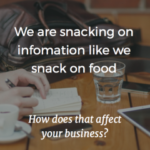In my last blog I highligheted the growing trend towards snack size information dominating the way we communicate. Is this a good thing or bad thing? I guess its irrellevant but what is important is how we communicate. By better understanding both positive and negative consequences, we can make better decisions about our own communication choices.
Here is a recap of what Snackification is:
What are the Positive aspects
It’s Fast and Efficient
Have you ever sent a text to a friend to say “I’m here”? You are waiting in the car for them and you cant be bothered talking to her husband or interacting with her kids, you just want to get going so you wait for her in the car. Texting is the most-used data service in the world; and when you factor in apps such as Messenger and WhatsApp, we send 80 billion messages a day. We send transactional texts to avoid explanations or long conversations. Texts are less intrusive and we can get right to the point. Snackified communication is faster.
It’s Genuinely Persuasive
Furthermore, exactly because it is less intrusive, this type of communication needs to be concise and compelling. In today’s world we are all competing for attention. Not only do we have to compete with a barrage of other quick communications, we also compete with other activities. We use our mobile devices to communicate while driving or walking, while at a party, or dinner or work. So if we want to cut through the clutter of a constant stream of communications, our messages need to be clear, concise and compelling.
So how do you gain attention and ensure that your message resonates?
You make it informal and appealing, so it’s easy to consume. A communication snack uses short sentences. It uses contractions, emoticons and image stickers to create colorful, casual messages. And it’s exactly this appealing, fun, authentic voice that can be quite compelling.
What are the Negative aspects?
Are we trading empathy for efficiency?
Snackified messages are so condensed and informal that they often fail to convey the intended emotional meaning and instead create more misunderstandings. And when we consider the overwhelming amount of electronic exchanges we have, some of which are with people we’ve never met in person or have never even had a phone conversation with, this just increases the chances of misinterpretation.
Written messages don’t carry the tone, pitch or emphasis of our voice, which can make it quite difficult to determine if someone is being e-serious or e-sarcastic, or if a person is just e-busy and not e-angry. When we don’t hear a voice or see a face, or fully understand the context of written words, we are bound to make incorrect assumptions, which in turn negatively impact how we view others.
Are We Now More Separate and Alone?
When you look at Facebook do you find yourself comparing your life with others? Do you get anxious finding just the right words so someone doesnt take offense. These are the impacts of this type of communication that we need to be aware of for our lives and the lives of our kids. It can affect your self esteem to think others are leaving you out or doing better than you.
Summary
There is no doubt that snackified communication is here to stay, and that it has definite advantages. We are able to stay in touch easily, letting loved ones know they are on our minds. We can get information to people quickly and efficiently. And sometimes it’s just plain fun. But as studies show, we have to be aware of its drawbacks and make necessary adjustments.
One adjustment you can make to counter this is to specifically express our emotions, like “I was sad …” or “I am surprised …,” and if necessary before hastily and negatively responding, clarify a confusing message by asking, “Here’s what I got … is that what you meant?”
Secondly, a little face-to-face time without digital devices goes a long way toward reducing emotional misinterpretation and increasing empathy. People will get a sense of the type of person you are and you them from these exchanges, no matter how brief, which will help them determine what sort of meaning is behind the words.
Interestingly, a Massachusetts Institute of Technology (MIT) researcher, Sherry Turkle, who studies how technology influences relationships, wrote a popular book titled Reclaiming Conversation: The Power of Talk in a Digital Age. She says we learn to develop empathy and intimacy through in-person conversations “where we learn to make eye contact, to become aware of another person’s posture and tone, to comfort one another and respectfully challenge one another.” Don’t be put off by “the boring bits” and awkward silences in a conversation, she cautions. “If the conversation goes quiet, you have to let it be. For conversation, like life, has silences. It is often in the moments when we stumble, hesitate and fall silent that we most reveal ourselves to one another,” she writes in a 2015 New York Times editorial titled “Stop Googling. Let’s Talk.”
“It is often in the moments when we stumble, hesitate and fall silent that we most reveal ourselves to one another.”— SHERRY TURKLE
There is no doubt in my mind that communiction with family and friends is being affected as well. Unfortunately, and because our technology is almost always with us, we have fewer of these types of meaningful conversations. One thing we can do for ourselves and our children is to schedule “digital holidays” or attend phone-free events.
Finally, Turkle also stated that “One start toward reclaiming conversation is to reclaim solitude. Some of the most crucial conversations you will ever have will be with yourself. Slow down sufficiently to make this possible. ” I think we all need solitude from time to time in this age where we are seemingly always in demand.
Summary- Finding a Healthy Balance
We need to communicate facts clearly and concisely, but we also need to communicate emotion accurately, and develop healthy, supportive, interpersonal relations. This can’t be done through snackified communication alone. Like a healthy diet, our communication must be balanced. And just as we see a new trend in snacks becoming more healthful, I am hopeful that understanding the influence of snackified communication will move us in a healthier direction.
What do you think?
Kerri Bainbridge
Collaborate, Mindset, Learning
One half of the Anywhere Team NZ



